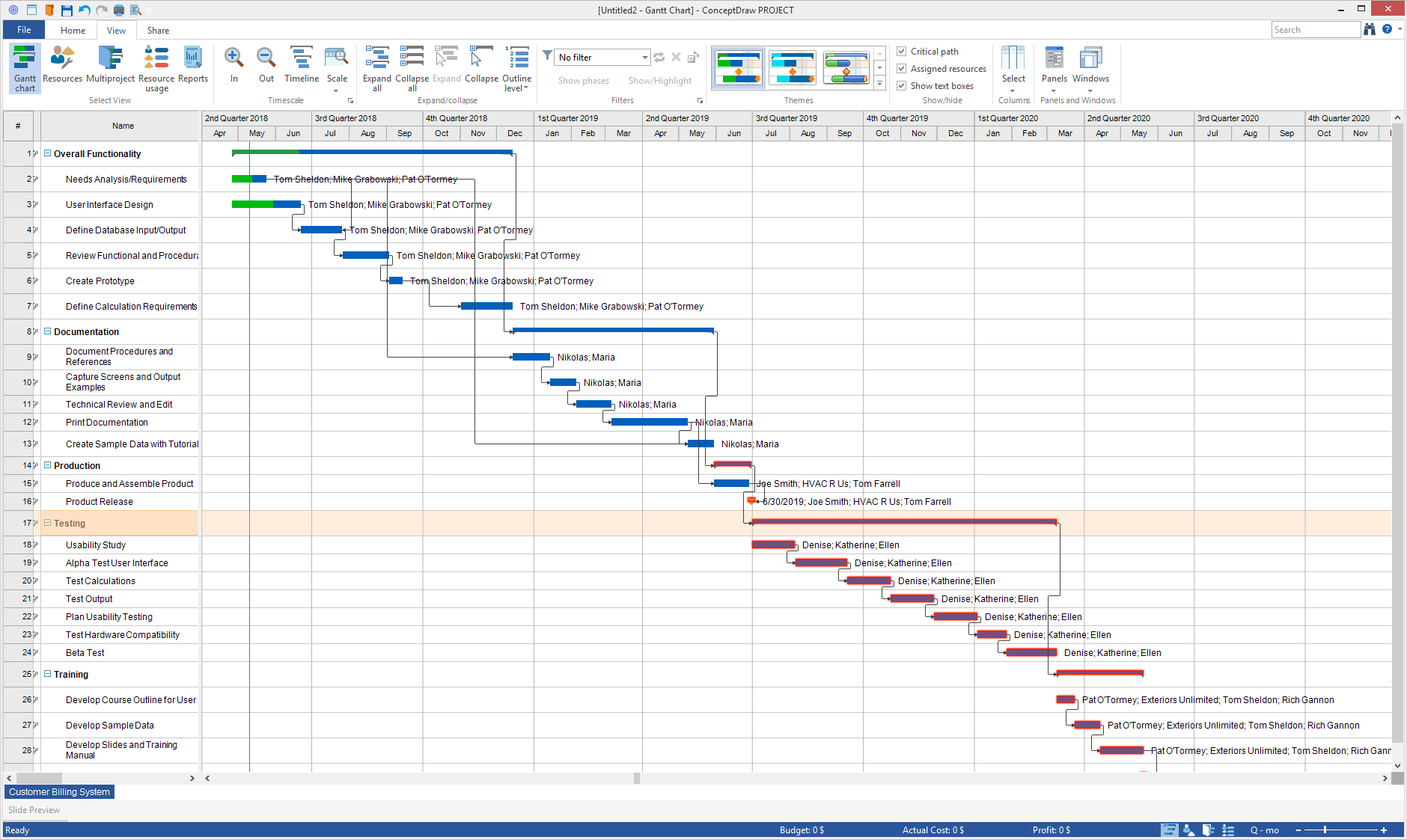Critical Path Method Project Management
Notice: Undefined offset: 0 in /var/www/html/conceptdraw/project-management/template.php on line 447
The critical path method may be also known as critical path analysis. Being an algorithm for scheduling a set of project activities, it can be used in critical path method project management. The critical path method is commonly used with the program evaluation and review technique known as PERT.
The critical path method is one of the most popular project modeling techniques. It was developed in the late 1950s by James E. Kelley and Morgan R. Walker. Both Walker and Kelley related their memories of the development of the critical path method in 1989. Thus, Kelley attributed the term "critical path" to the developers of the “Program Evaluation and Review Technique”. The critical path method technique was developed and put into practice between 1940 and 1943 by DuPont. It contributed to the success of the so-called “Manhattan Project”.
Critical Path method is a commonly used technique for all forms of projects. Such projects include aerospace and defense, construction, software development, product development, plant maintenance, engineering, research projects, etc. Any project that has the interdependent activities can apply the Critical Path method of mathematical analysis. For the first time, Critical Path Analysis was used for major skyscraper development. It was in 1966 while constructing in New York City the former World Trade Center Twin Towers. The term is usually known to be applied to any approach used for analyzing a project network logic diagram.
The essential technique for using Critical Path method in Critical Path method project management is to construct a model of the project that includes a list of all activities required for completing the project, the duration that each activity will take to complete, the dependencies between the activities and the logical end points (e.g., deliverable items or milestones).
Using the mentioned values, Critical Path method calculates the longest path of planned activities to the end of the project or to logical end points. Also, the earliest and latest point that each activity can start and finish without making the project longer should be mentioned on the path. Such process may help with determining which activities are "critical" and which have the so-called "total float". In project management, a critical path is simply the sequence of project network activities that add up to the longest overall duration, determining the shortest time possible for completing the project.
A project can have parallel, several and near critical paths. Some or all of these tasks could have 'free' and 'total’ float. Any additional parallel path through the whole network that has the total durations shorter than the critical path is known to be called as either a “sub-critical” or a “non-critical” path. All the activities on the sub-critical paths have no drag.

Notice: Undefined variable: patterns in /var/www/html/conceptdraw/project-management/template.php on line 504
Warning: Invalid argument supplied for foreach() in /var/www/html/conceptdraw/project-management/template.php on line 504
Pic 1. Critical Path Method Project Management
Critical Path Method analysis tools allow any ConceptDraw PROJECT user to select a logical end point in a project. To quickly identify its longest series of dependent activities is also always possible. The mentioned tools can display the critical path as a cascading waterfall which flows from the project's start to some particular logical end point.
Although the so-called PERT Chart is still widely used, it has been recently superseded by the “activity-on-node diagram”. On this diagram, each of the activities is shown as a node or a box. The arrows within such illustration represent the logical relationships from a predecessor to a successor.
Critical path drag analysis can be also used for optimizing schedules in processes outside of strict project-oriented contexts. Thus, it can be used for increasing manufacturing throughput in a way of using the appropriate techniques and metrics for identifying and alleviating all the delaying factors, reducing the assembly lead time in this way.
Crash duration may be a term referring to the shortest possible time for which some particular activity within a project can be scheduled. Shifting more resources towards the completion of that activity may help in this situation. Getting the decreased time spent as well as a reduced quality of work, crash duration may be modeled as a linear relationship between activity and cost duration.
Since its development, the critical path method considered only logical dependencies between terminal elements for a long time. Although, it has been expanded so now it allows the inclusion of resources related to each activity. It has become possible through using such processes as the “resource leveling” and the “activity-based resource assignments”. The so-called “resource-leveled schedule” may sometimes include the delays due to resource bottlenecks. It may lead to reducing the previous path in order to become the longest one.
Critical Path Method is known for allowing the continuous monitoring of the schedule. It allows the project managers to track all the critical activities. In order to use the critical path method, the ConceptDraw PROJECT application can be used. Having such creative project management software as ConceptDraw PROJECT one, any project manager may benefit from it using the advantages listed below:
- Viewing all the resource assignments on tasks in all the ongoing projects,
- Identifying resource overload areas in projects,
- Adjusting the resource overload areas in projects from a single view,
- Using the Unique Multiproject Dashboard that allows managing multiple projects from a single file,
- Having a mutual multi-project resource pool that allows organizing all resources’ usage with their maximum efficiency, and many other pros.
Once you decide to try this product of CS Odessa, you can simply download it from this site. As long as it is installed, you can use all the advantages of this progressive critical path method project management application. Thus, managing the multiple projects at the same time arranging work on multiple tasks within each of them has become much simpler.